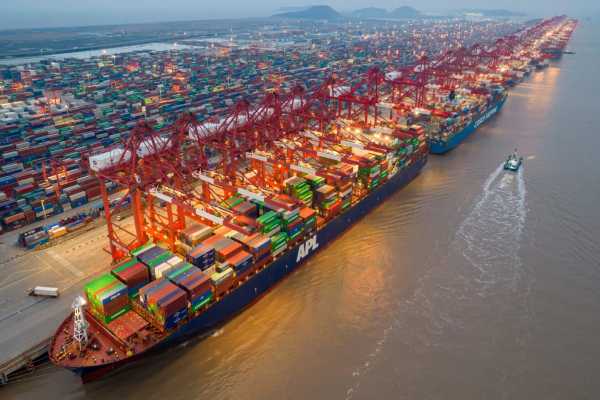The 10 Largest Ports in the World 2023
Maritime trade has been one of the main exponents of the economy since the beginning of trade in general. Currently, the world’s ports handle millions of containers every month. But what are the biggest ports in the world in terms of cargo movement?
Today we are going to see which are the 10 largest ports in the world and discover some interesting facts about each one.

If you want to know each of the 10 largest ports in the world, read until the end!
10 Largest Ports in the World
And how could it be otherwise, who dominates the list? China has no less than 7 of the 10 largest ports in the world.
This, in fact, is an interesting fact that we will show later: Asian dominance in this sector of foreign trade, since only one port is European, and none in the Americas.
1st – Port of Shanghai, China
The port of Shanghai, currently the largest port in the world, is located in the city of Shanghai, which in addition to being a deep-water port, also has a river port.
In addition to being first on the list of largest ports in the world, this port has history, which makes it so interesting.
The Shanghai region has commercial and maritime activities that date back to the 5th century, but it was in the 19th century that the port of Shanghai was born, with the Treaty of Nanking, after the end of the Opium War.
A nearly decade-long international conflict between China and the United Kingdom over control of the Opium trade.
Since then, the port has been modernized until in the early 90s it was renovated and expanded, and in 2005 it began to have river access. In addition to Shanghai, the largest port complex in the world has three more ports:
- Wusongkuo Port (Wusong)
- Waigaoqiao Port
- Yangshan Deepwater Port
It is a port with centuries of history, which has received extensive investment from the Chinese government in recent history and which has the privilege of having access by river and sea, that is, by river and by sea.
For twelve years it has occupied first place in the ranking of the busiest container port in the world (first place was held by the port of Singapore).
At the end of 2017, the largest of the world’s largest ports became home to the world’s largest freight terminal (Shanghai Yangshan Deep Water Port) with an automated ship loading and unloading system.
In 2021, this port handled an impressive 47.03 million TEUs and is responsible for approximately 26% of all Chinese Foreign Trade.
2nd – Port of Singapore, Singapore
Among the largest ports in the world, it is currently the second busiest, and the first, in terms of cargo tonnage, with around 1.2 billion.
In 2021, the port of Singapore handled 37.5 million TEUs, an increase of one million TEUs compared to the previous year.
The port of Singapore is crucial for the movement of food, ore and materials, as Singapore is a small island with limited production.
Still, the port is among the largest ports in the world because 80% of the ship fleets pass through it to defuel and refuel. It is connected to more than 120 countries and 600 other ports.
It is also considered one of the largest ports in the world because it has the largest refrigerated container allocation capacity in the world.
Currently, Singapore has 52 terminals and is managed by PSA Singapore and Jurong.
The port grew significantly after economic reforms in the 80s and 90s. Without any natural resources, commerce and industry became the country’s main levers.
Therefore, it is expected to be able to process 65 million TEUs per year when the expansion is fully completed in 2040.
3rd – Ningbo-Zhoushan Port, China
This port, located in Ningbo and Zhoushan, on the coast of the East China Sea, in Zhejiang province, south of Hangzhou Bay, which faces Jiaxing and Shanghai, handled 31.08 million TEUs in 2021.
Ningbo also produces household appliances and its port movement surpassed the mark of 1 billion tons of cargo in 2019 — considered, at the time, the largest volume in China.
Its main cargoes are manufactured commodities and raw materials, such as coal, crude oil and petroleum, machinery and grains, which pass through routes destined for Oceania, North and South America.
In 2019, the port opened a new terminal with capacity for over 10 million TEUs, which may have helped it achieve the large percentage increase it had.
Even though it is one of the largest ports in the world, it is also responsible for intense maritime pollution due to the high movement of ships in the East Chinese Sea, causing great environmental impact.
4th – Port of Shenzhen, China
Shenzhen, located north of Hong Kong, is one of China’s richest cities and the first Special Economic Zone.
And as the name says: she is special. It has different tax, customs and tax laws.
The objective is to promote economic development and attract investment. This is very relevant to understand why China has so many regional differences: some places really are privileged by the government’s strategic decisions.
The port of Shenzhen is actually a collection of several ports that exist along the coast of Shenzhen, in Guangdong province, China.
In the case of Shenzhen, no less than 90% of the production of electronics sold in the world, that is, 9 out of 10 devices, are manufactured there.
This is where most iPhones and video games come from, making China the largest exporter of electronic products in the world.
5th – Guangzhou Port, China
And here we have another Chinese secular giant. Founded, as it is known today, in 2004, it is completely controlled by a state-owned company.
Located in Guangdong Province, its international maritime trade reaches more than 300 ports in more than 80 countries and districts around the world.
But how could a port become one of the largest ports in the world so quickly?
Firstly, because like the Port of Shenzhen, this port is made up of several small ports in its infrastructure, and the three main ports of this complex are the ports of Nansha, Xinsha, and Huangpu, with Nansha alone being responsible for 70% of the maritime traffic of the Guangzhou ports.
Secondly, the port of Huangpu is already centuries old. That’s right, during the Opium War, Huangpu was the only Chinese port open to international trade.
Thirdly because Guangzhou, also known as “Canton”, is the headquarters of the “Canton Fair”, one of the largest trade fairs in the world, and is also an economic, technological and industrial investment zone.
6th – Port of Qingdao, China
Located in the Yellow Sea region, which gets its name due to the masses of alluvium thrown into it by the Yellow River, the port of Qingdao is a maritime terminal in the province of Shandong, also in China.
Qingdao Port began operations in 1892 and is located between the Bohai Rim port region and the port region at the mouth of the Yangtze River.
The city itself is an important center for marine scientists and technology innovators, so the port motivates and supports the local economy that benefits from Foreign Trade.
With routes connecting more than 700 ports in more than 80 countries, the port of Qingdao handles various types of bulk cargo, such as coal, iron ore, crude oil, grains, among others.
This port is one of the largest commercial centers and provides a crucial connection to the western Pacific, in addition to being recognized as one of the largest ports in the world for handling crude oil and iron ore from China, capable of serving large ships and tankers.
7th – Port of Busan, South Korea
And here in seventh place, China takes a break and makes room for another Asian technology powerhouse.
The port of Busan is the largest in South Korea. It is located at the mouth of the Nakdong River, the largest in Japan.
Another centuries-old port, the port was opened in 1870 with the aim of facilitating trade between Korea, China and Japan.
In the 70s Busan developed with the production of footwear, bringing the population to 3 million inhabitants and making it one of the largest and most important cities in the country.
Composed of 4 smaller ports and two terminals, the largest trading partners are the United States, China, Vietnam, Germany and Hong Kong.
8th – Port of Tianjin, China
Tianjin Port, once titled Tanggu Port, is the largest port in northern China, and the main source of maritime foreign trade from Beijing to the Yellow Sea.
With commercial connections to more than 600 ports in 190 countries and regions, the port is responsible for handling diverse types of cargo, including coal and oil terminals, as well as terminals that handle dry and liquid bulk cargo.
Despite the drop it has seen since 2015, due to the tragedy with a series of explosions of stored chemical compounds, which killed 173 people and left more than 800 injured, the port of Tianjin remains among the 10 largest ports in the world.
9th – Port of Hong Kong, China
The port of Hong Kong is located in southern China, between the city and Hong Kong Island. It is an extremely modernized deepwater vessel and has 9 container terminals.
Even though it has one of the smallest areas for processing and storing cargo, the port of Hong Kong is fully capable of meeting the demand of the Hong Kong administrative region and connecting to around 470 other ports in the world.
The port of Hong Kong is dominated by trade in manufactured goods and, to a lesser extent, raw materials. Furthermore, the port of Hong Kong is among the largest ports in the world for its capacity to maintain and repair cargo ships, but also to produce leisure and patrol ships for the international community.
Read Also: The 7 Best Airports In The World
10th Port of Rotterdam, Netherlands
The port of Rotterdam, despite being the largest port in Europe, spent a long time without entering the top 10 largest ports in the world, however, in 2021, the port located in the Netherlands returned to position 10 in the ranking, with movement of 14.8 million TEUs, a drop of 0.8 million TEUs compared to 2019.
Interestingly, between 1962 and 2004, the port of Rotterdam occupied first place among all ports in the world, but was then surpassed by Asian production and consumption powers.
It is estimated that more than 50 million people in the European Union depend on this port.
Tenth largest port in the world, the port of Rotterdam is also one of the most modern ports in the world. Its terminals have fully automated processes, with robotic cranes and autonomous cars.

![The 10 Worst Nuclear Disasters Ever Recorded [INES & IAEA] 3 The 10 Worst Nuclear Disasters Ever Recorded [INES & IAEA]](https://allroundgist.com/wp-content/uploads/2022/11/worst-nuclear-disasters-ever-recorded-img_13362-min.jpg)

![Top 10 Best Fashion Schools In The World [2023] 5 Top 10 Best Fashion Schools In The World](https://allroundgist.com/wp-content/uploads/2023/03/best-fashion-schools-in-the-world-img_1121-min.jpg)



https://t.me/s/Irwin_officials
https://t.me/officials_pokerdom/3121